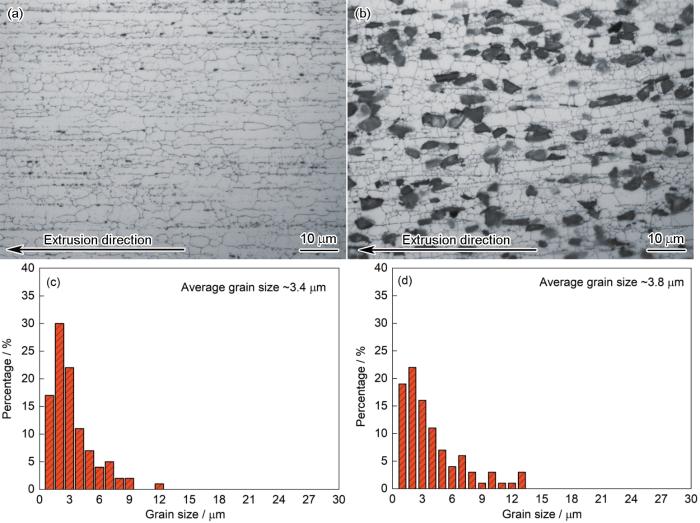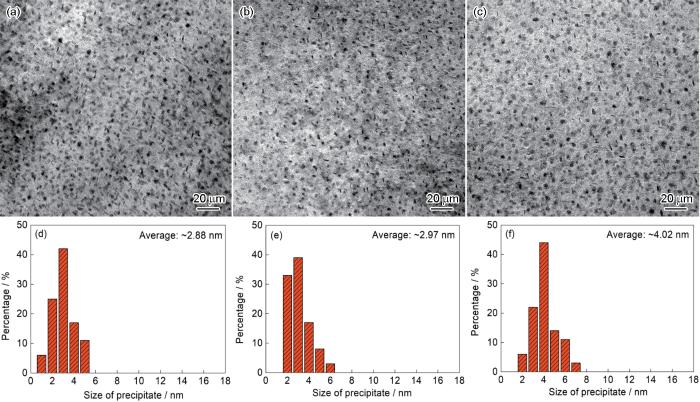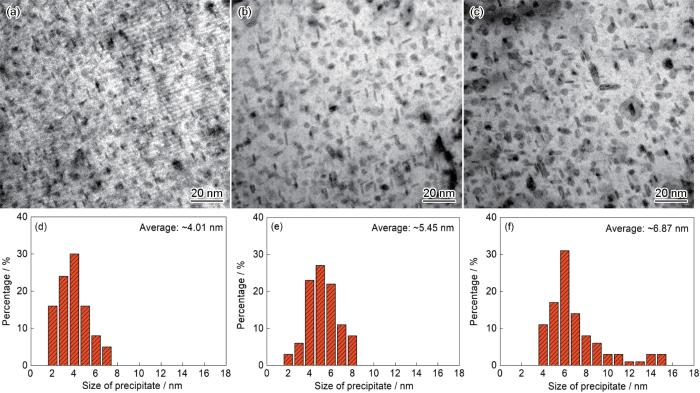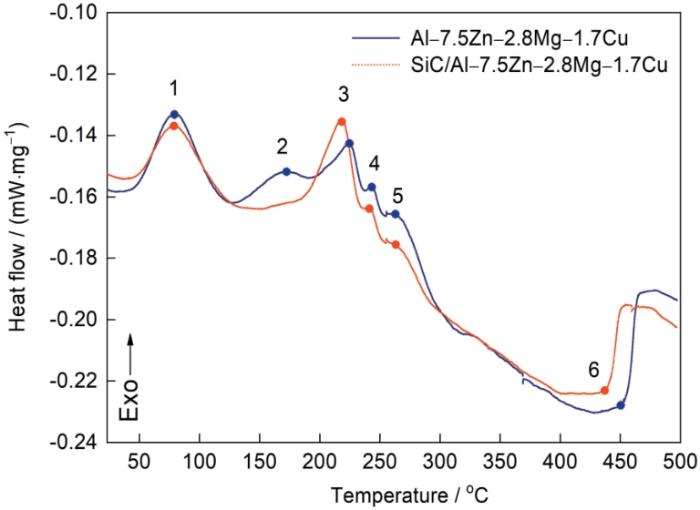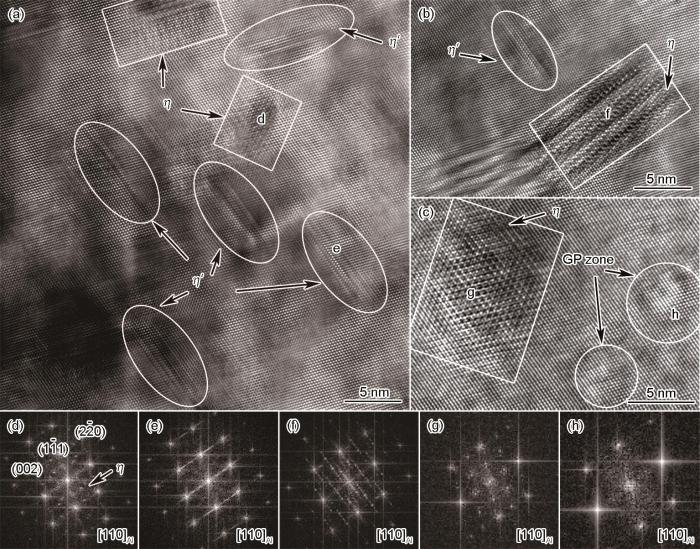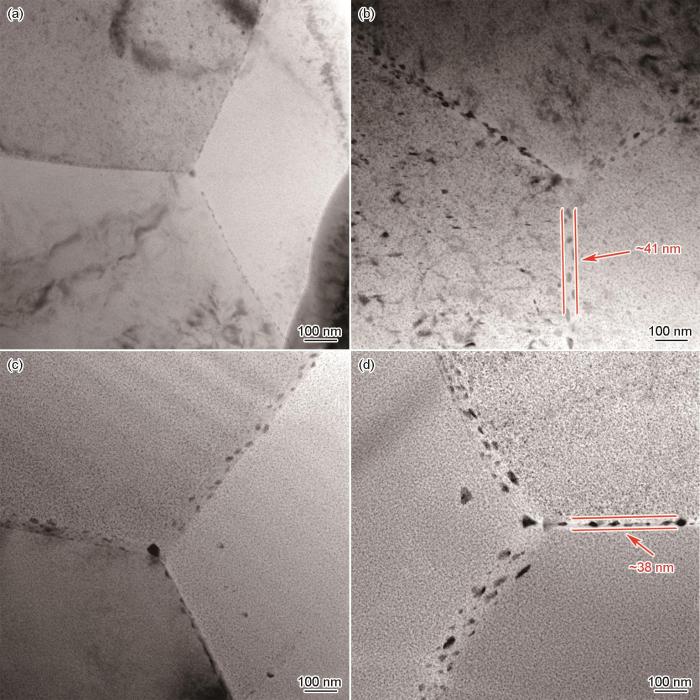颗粒增强铝基复合材料(particulate reinforced aluminum matrix composites,PRAMCs)比传统铝合金具有更高的强度、模量、导热性、尺寸稳定性和耐磨性,成为传统金属材料以外的重要工程材料[1,2]。目前,以Al-Mg-Si和Al-Cu-Mg合金为基体的PRAMCs研究相对成熟,已被广泛应用于核电、航空航天和交通运输等领域[3~6]。然而,受基体合金强度的限制,以往研发的复合材料强度仍然较低,难以满足新型装备对承载结构件的设计要求。Al-Zn-Mg-Cu合金作为可时效硬化铝合金,具有更明显的强度优势,其强度高于大多数SiC/Al-Mg-Si和SiC/Al-Cu-Mg复合材料[7,8]。因此,开发以Al-Zn-Mg-Cu合金为基体的复合材料,对提高PRAMC强度和促进结构轻量化的发展具有重要意义。
遗憾的是,SiC颗粒对Al-Zn-Mg-Cu合金的强化效果一直不理想,甚至出现强度不升反降的现象[9~11],极大地限制了SiC/Al-Zn-Mg-Cu复合材料的研究与发展。影响SiC/Al-Zn-Mg-Cu复合材料力学性能的因素有很多,包括增强颗粒参数、基体合金成分和热处理工艺等。选择合理的基体成分配比,获得高密度第二相,再结合适当的T6热处理工艺[12~14]可以将冶金过程形成的粗大相充分固溶,并在基体中重新析出细小、弥散分布的纳米沉淀相,获得最佳硬化效果,这些纳米相可以有效地钉扎位错,从而极大地提高复合材料拉伸强度[15~17]。相比于未热处理SiC/7085Al复合材料[18],T6态复合材料的抗拉强度可以提高184 MPa,屈服强度提高138%。因此,采用合理的T6热处理工艺,充分发挥沉淀相的强化作用是提高SiC/Al-Zn-Mg-Cu复合材料性能的关键。
然而,目前大部分SiC/Al-Zn-Mg-Cu复合材料采用的是与未增强合金相同的T6热处理工艺[19],T6态复合材料中沉淀相尺寸更大、密度更低,沉淀强化能力明显减弱,导致复合材料力学性能不佳。复合材料与未增强合金的时效行为的差异一直被忽略,2者在相同的热处理条件下,可能处于不同的时效状态。一方面,时效析出过程受合金中化学成分的影响。对于复合材料,SiC/Al界面反应将改变基体中的化学成分[18,20],降低溶质原子过饱和度,影响沉淀相的析出动力学,从而改变最佳时效处理时间。另一方面,由于SiC与Al的热膨胀系数不同[6],热加工后在近界面处将产生大量的错配应力,应力通过位错增殖而松弛,这些位错可以提高溶质原子的扩散速率,影响沉淀相的析出和长大。因此,优化SiC/Al-Zn-Mg-Cu复合材料的T6热处理工艺,对提高复合材料的力学性能十分必要。此外,SiC/Al-Zn-Mg-Cu复合材料的硬度和强度,很大程度依赖于纳米沉淀相的析出状态,而目前针对SiC/Al-Zn-Mg-Cu复合材料沉淀相演变规律的研究十分有限,SiC颗粒对Al-Zn-Mg-Cu合金沉淀相尺寸、种类、密度和分布的影响规律亟待厘清。
本工作采用粉末冶金法制备了含15%SiC (体积分数)的SiC/Al-7.5Zn-2.8Mg-1.7Cu (质量分数,%,下同)复合材料以及Al-7.5Zn-2.8Mg-1.7Cu合金,通过对比2者的硬度、电导率和力学性能随时效时间延长的变化趋势,确定了其最佳峰时效处理工艺,阐明了SiC颗粒对SiC/Al-Zn-Mg-Cu复合材料时效行为的影响规律,旨在对SiC/Al-Zn-Mg-Cu复合材料时效热处理工艺优化提供指导。
1 实验方法
基体合金名义成分为Al-7.5Zn-2.8Mg-1.7Cu。实验用金属粉末及磨料级SiC颗粒纯度均在99.5%以上,SiC粉末粒径约为7 μm,复合材料中SiC颗粒的体积分数为15%。将粉末机械混合均匀后装入模具内,通过真空热压烧结法制备坯锭,详细的热压工艺见文献[20]。坯锭在420℃下挤压成棒材,挤压比为17∶1。为了对比SiC颗粒添加前后材料组织演变特征差异,采用相同工艺另制备同成分下的未增强合金。2种材料的挤压试棒均在470℃下固溶处理2 h,经水淬后,置于120℃的电热鼓风干燥箱中进行不同时间的时效处理,从而获得不同时效状态的试样。
利用电火花切割技术,沿挤压方向分别获取2种材料的金相样品,并经水磨砂纸磨至2000号后进行机械抛光。经化学试剂(1 mL HF + 16 mL HNO3 + 83 mL H2O + 3 g CrO3)腐蚀后,使用Axiovert 200 MAT金相显微镜(OM)观察复合材料和未增强合金的微观组织,并利用Image-Pro Plus软件对其晶粒尺寸进行统计。使用TA-Q1000差示扫描量热仪(DSC)在Ar气保护下对固溶处理后的样品进行分析。实验条件为以10℃/min的升温速率,从室温升到500℃。采用HV-1000硬度测试仪和D60K电导率仪对时效样品的显微硬度和电导率演变规律进行分析。使用Tecnai G2 F20透射电镜(TEM)观察不同时效状态复合材料及其合金中的析出相形貌,并对其尺寸进行统计。
根据时效硬度曲线,使用Instron 5848电子万能试验机对不同时效状态下的样品进行拉伸测试,应变速率为1 × 10-3 s-1,试样标距为20 mm,宽约3.8 mm,厚约2.3 mm,拉伸方向与挤压方向平行。为确保数据可靠性,每种时效状态的材料测试5个拉伸样品,并计算平均值。
2 实验结果与讨论
2.1 合金及其复合材料的金相组织
图1a和b所示为挤压态Al-7.5Zn-2.8Mg-1.7Cu合金和SiC/Al-7.5Zn-2.8Mg-1.7Cu复合材料显微组织的OM像。2者均致密,且无明显的冶金缺陷,如孔洞和裂纹等。经挤压变形后,未增强合金的晶粒有被拉长的趋势,晶粒的长轴方向平行于挤压方向(图1a)。如图1c所示,根据晶粒尺寸定量分析,未增强合金的平均晶粒尺寸约为3.4 μm,晶粒尺寸分布比较集中。复合材料中的SiC颗粒分布均匀(图1b),无明显团聚,热挤压过程中颗粒随Al基体的塑性变形而发生转动,其长轴趋向平行于挤压方向分布。由于SiC颗粒变形与基体变形不一致,在颗粒周围极易产生应力集中,应力通过位错增殖而松弛,这些位错可以诱导新晶界形成[21],导致靠近SiC颗粒以及颗粒间距较小的区域,晶粒尺寸也更小。如图1d所示,复合材料平均晶粒尺寸与未增强合金相近,约为3.8 μm,但其晶粒尺寸均匀性较低。
图1
图1
挤压态未增强合金(Al-7.5Zn-2.8Mg-1.7Cu)及复合材料(SiC/Al-7.5Zn-2.8Mg-1.7Mn)棒材显微组织的OM像和晶粒尺寸统计柱状图
Fig.1
OM images (a, b) and grain size statistic plots (c, d) of as-extruded Al-7.5Zn-2.8Mg-1.7Cu alloy (a, c) and SiC/Al-7.5Zn-2.8Mg-1.7Cu composite (b, d)
2.2 时效时间对材料硬度和电导率的影响
图2为未增强合金和复合材料在120℃下时效0~48 h的硬度和电导率曲线。如图2a所示,时效2 h的未增强合金硬化效果十分显著,相比于未时效的合金,其硬度提高了26%。随时效时间继续延长,硬度缓慢升高,直到时效24 h硬度达到最大值209 HV。如图2b所示,复合材料时效10 h硬度已经达到最大值238 HV,比基体合金提前约14 h。时效10~24 h,复合材料始终保持较高的硬度,时效24 h复合材料硬度也为238 HV,且比未增强合金最大硬度高29 HV。时效24 h之后,复合材料和未增强合金的硬度均开始缓慢下降。SiC颗粒对复合材料时效进程起到明显的促进作用,尤其在时效2~10 h,复合材料的电导率快速升高,说明已有相当多的溶质原子脱溶,而这个阶段未增强合金的电导率变化十分微弱。未增强合金中沉淀相析出更接近于均匀形核,时效前期,固溶原子优先形成密集的原子团簇和与Al基体共格的GP (Guinier-Preston zone)区,对电导率的提升有限。时效10~24 h,未增强合金和复合材料的电导率均显著升高,且在时效24 h时,2者的电导率均达到相对较高的值,时效时间继续延长,电导率升高十分缓慢。
图2
图2
120℃单级时效未增强合金和复合材料样品的硬度和电导率曲线
Fig.2
Aging hardness and electrical conductivity curves of the single-stage aged Al-7.5Zn-2.8Mg-1.7Cu alloy (a) and SiC/Al-7.5Zn-2.8Mg-1.7Cu composite (b) at 120oC (IACS—international annealed copper standard)
2.3 不同时效状态下材料的力学性能
图3为120℃时效0、2、8、10、24和48 h的未增强合金和复合材料的拉伸性能。如图3a所示,时效2 h未增强合金的抗拉强度(UTS)和屈服强度(YS)均大幅度提高,而延伸率(EL)明显下降。随时效时间继续延长,UTS和YS提升缓慢,直到时效24 h,UTS (662 MPa)和YS (637 MPa)同时达到了最大值,此时EL为10.0%。延长时效时间,UTS、YS和EL均下降。拉伸性能测试结果与硬度曲线基本吻合,结合硬度、电导率和力学性能确定120℃时效24 h为Al-7.5Zn-2.8Mg-1.7Cu合金的T6热处理工艺。如图3b所示,复合材料的力学性能变化规律与基体合金基本一致。时效0~2 h,复合材料快速强化,UTS提高了37%;在时效8~10 h阶段,复合材料强塑性一直处于较高水平,且变化微弱。时效8 h复合材料的UTS已经达到了650 MPa,继续时效至第一次硬度最高点(120℃、10 h),复合材料YS达到了最大值(625 MPa);时效至第二次硬度最高点(120℃、24 h),复合材料UTS达到了最大值(663 MPa)。由于SiC颗粒对Al-Zn-Mg-Cu基体沉淀相的析出有促进作用,导致复合材料比未增强合金提前14 h达到最大硬度和最高屈服强度。然而,如图2b所示,时效10~24 h,电导率持续升高,说明仍有较多溶质原子继续脱溶,已形成的沉淀相可能逐渐粗化,导致复合材料屈服强度略有降低,但是复合材料加工硬化能力提高使得UTS进一步提升。根据硬度和UTS达到最高值的时效时间点定义,SiC/Al-7.5Zn-2.8Mg-1.7Cu复合材料的T6热处理工艺应为120℃保温24 h。
图3
图3
未增强合金和复合材料在120℃下时效0、2、8、10、24和48 h的力学性能
Fig.3
Tensile properties of Al-7.5Zn-2.8Mg-1.7Cu alloy (a) and SiC/Al-7.5Zn-2.8Mg-1.7Cu composite (b) aged at 120oC for 0, 2, 8, 10, 24, and 48 h (UTS—ultimate tensile strength, YS—yield strength, EL—elongation)
2.4 合金及其复合材料析出相的析出行为
图4所示为不同时效状态未增强合金沿[110]Al方向观察的析出相形貌。如图4a所示,在120℃时效2 h后未增强合金的析出相尺寸较小,分布十分均匀。η'相在三维空间中是具有一定厚度的圆盘状,时效过程中,优先沿直径方向生长,而厚度几乎保持恒定[22]。由于沉淀相与Al基体有多种取向关系,因此[110]Al平面上η'相的投影可以表现为圆盘状或短棒状[23] (图4a)。如图4b和c所示,随着时效时间的延长,时效10和24 h后未增强合金中析出相的形态、尺寸和密度并无明显差异,说明在不升高时效温度的条件下,析出相的长大是非常缓慢的。因此,在较长的时效时间里,未增强合金能保持高硬度和高强度(图2a和3a)。为了进一步分析析出相尺寸的变化规律,对各状态下合金的析出相尺寸进行统计(图4d~f)。时效2、10和24 h未增强合金的析出相平均尺寸分别约为2.88、2.97和4.02 nm。随时效时间的延长,析出相尺寸缓慢增大,且尺寸分布均比较集中。
图4
图4
不同时效状态未增强合金沿[110]Al方向的析出相形貌和尺寸统计柱状图
Fig.4
Precipitation morphologies (a-c) and size statistic plots (d-f) of Al-7.5Zn-2.8Mg-1.7Cu alloy under different aging treatment conditions taken along [110]Al zone axis (a, d) under-aged (120oC, 2 h) (b, e) under-aged (120oC, 10 h) (c, f) T6-treated (120oC, 24 h)
图5为不同时效状态复合材料沿[110]Al方向观察的析出相形貌。复合材料中析出相的形态与未增强合金的基本相似,而相同时效条件下复合材料析出相的尺寸和两相之间距离均比基体合金的更大(图5a~c),说明SiC颗粒对沉淀相的析出和长大具有明显的促进作用。如图5d~f所示,在120℃时效2、10和24 h后复合材料析出相的平均尺寸分别约为4.01、5.45和6.87 nm。各时效状态下复合材料析出相的尺寸分布均比未增强合金更加分散。一方面,SiC颗粒与Al基体之间的热膨胀系数不同,热变形加工或热处理后可能在近界面基体内引入错配位错,导致位错增殖[24],位错线可以引起析出相的异质形核和优先长大[25],导致析出相尺寸不均匀。另一方面,SiC颗粒也能引起基体中Mg元素分布不均匀[18],在Mg含量较高的区域,溶质原子的高含量有利于MgZn2相的长大,也可能导致析出相尺寸不均匀。
图5
图5
不同时效状态复合材料沿[110]Al方向的析出相形貌和尺寸统计柱状图
Fig.5
Precipitation morphologies (a-c) and size statistic plots (d-f) of SiC/Al-7.5Zn-2.8Mg-1.7Cu composite under different aging treatment conditions taken along [110]Al zone axis (a, d) under-aged (120oC, 2 h) (b, e) under-aged (120oC, 10 h) (c, f) T6-treated (120oC, 24 h)
图6
图6
固溶态未增强合金和复合材料的DSC曲线
Fig.6
DSC curves of the solution treated (470oC, 2 h) unreinforced alloy and composite
表1 固溶态未增强合金和复合材料DSC曲线中各峰值点(见图6)的温度 (oC)
Table 1
| Peak | Unreinforced alloy | Composite |
|---|---|---|
| 1 | 79 | 79 |
| 2 | 172 | - |
| 3 | 224 | 218 |
| 4 | 243 | 240 |
| 5 | 262 | 262 |
| 6 | 450 | 438 |
根据已有研究报道[26,27],未增强合金中,峰1和峰2分别与GP区和η'相的形成有关;峰3和峰4对应的是2种类型η相的析出;对于峰5的分析目前没有明确的结论,但是普遍认为其可能与S相的形成有关;峰6则是由η相溶解吸热所形成的。与基体合金相比,复合材料中峰1有轻微的削弱,说明形成GP区的含量略有降低。峰2几乎消失,说明复合材料中η'相的析出量极低,甚至可能没有。但这与以往的研究结果不符,Wu等[28]认为B4Cp/Al-Zn-Mg-Cu复合材料的时效析出序列依然与Al-Zn-Mg-Cu合金一致,即过饱和固溶体(SSS)-GP区-η'相-η相。也有研究[29]表明,部分η相的形核可以不经过η'相,而是由SSS直接转变而成,因此时效析出序列可能会被改变。而在SiC/Al-Zn-Mg-Cu复合材料中,η'相的析出进程很可能被加速,使得低温时已有部分η'相形核。η'相以均匀的速度在复合材料中析出,集中放热的现象被减弱,导致峰2不明显。复合材料的峰3和峰6均向左平移,说明η相的形成和溶解动力学均被加速。
图7所示为T6态(120℃、24 h)复合材料沿[110]Al方向的析出相HRTEM像和典型析出相的快速Fourier变换(FFT)花样。在图7a~c中,方框标出的析出相与Al基体是非共格关系,该相为η相[7,26],其形貌为圆盘状或粗棒状。图7d、f和g是对应图7a~c中指定区域的FFT花样,可以明显观察到花样中除Al基体的斑点以外还存在η相的斑点[30]。析出相形成过程中可能存在层错,使得斑点有拉丝现象(图7f)。椭圆标出的析出相与Al基体是半共格关系,该相为η'相[26,30],其形貌多为细长的棒状。图7e为η'相的FFT花样,由于η'相是过渡相,与Al基体的晶格错配角较小,因此η'相的斑点较微弱[31],但是在η'相的高分辨像中可以观察到晶格畸变和错配现象(图7a)。图7c中圆圈标出的析出相是与Al基体完全共格的GP区,其形貌为小圆盘状。图7h显示的是GP区的FFT花样,花样中只有Al基体的斑点,且GP区的高分辨点阵与Al基体完全共格。在T6态复合材料中,GP区、η'相和η相同时存在,且根据各相数量分析,其主要强化相为η'相。然而DSC曲线中代表η'相析出的放热峰2十分微弱,这与在HRTEM下观察到大量η'相的结果不符。由于SiC颗粒加入铝合金基体中,引入了大量的界面和错配位错[6],为沉淀相提供形核质点,促进异质形核[18,22]。因此,部分GP区可能以异质形核的方式优先析出,随温度升高,另一部分GP区以均质形核的方式析出,先后形成的GP区分别长大,并向η'相转化。GP区向η'相的转化过程被分散,导致复合材料DSC曲线峰2不明显,但复合材料的时效析出序列未改变,仍为SSS-GP区-η'相-η相。
图7
图7
T6态复合材料沿[110]Al方向的析出相高分辨透射照片和快速Fourier变换花样
Fig.7
HRTEM images (a-c) of the precipitation in the T6 treated composite taken along [110]Al zone axis, and the fast Fourier transformation (FFT) patterns (d-h) of the marked zone in the HRTEM images in Figs.7a-c
图8显示的是不同时效状态未增强合金和复合材料晶界的TEM明场像。如图8a和c所示,时效2 h的基体合金和复合材料晶界上均有明显的第二相析出,且复合材料晶界相的数量更多一些。由于时效时间较短,晶界相的尺寸均较小。如图8b和d所示,在时效24 h的未增强合金和复合材料中,晶界处无析出带(PFZ)开始形成,其宽度分别约为41和38 nm。晶界相均是非连续的,且与欠时效态(120℃、2 h)材料相比,其尺寸和数量都有明显增加。随时效时间的延长,晶界相不断长大。各时效状态下,复合材料与未增强合金晶界的PFZ宽度差异不大,但是复合材料晶界相的数量明显更多,这可能是由于晶界能量较高,容易引起析出相优先析出和元素的偏聚[18],而复合材料中的错配位错加速了溶质原子扩散,促进了晶界相的形核和长大[25,32]。晶界相的长大需要消耗周围的溶质原子,使得晶界附近溶质原子贫化而形成具有一定宽度的PFZs。复合材料中溶质原子扩散速率快,溶质原子的补偿能力强,因此在复合材料晶界相更多的情况下,PFZ宽度依然略低于未增强合金。晶界相(图8d)的形成和SiC/Al界面反应都将消耗部分溶质原子,是复合材料晶粒内部析出相密度降低的主要原因(图4)。
图8
图8
未增强合金和复合材料不同时效处理后晶界的TEM明场像
Fig.8
Bright-field TEM images of grain boundaries of the unreinforced alloy (a, b) and the composite (c, d) (a, c) aging 2 h at 120oC (b, d) T6-treated (120oC, 24 h)
综上所述,相同时效条件下复合材料的时效析出进程明显比未增强合金更快,SiC颗粒的加入促进析出相的析出和长大。时效2 h复合材料的沉淀相平均尺寸已达到4.01 nm,接近时效24 h未增强合金沉淀相水平。时效2~10 h,复合材料电导率上升明显快于未增强合金,GP区向η'相的转化速率被加快。由于GP区具有均质形核和异质形核2种形成方式,其析出过程存在先后差异,先形成的GP区迅速长大并向η'相转化,η'相形成过程被分散,导致复合材料DSC曲线中η'相形成的放热峰弱化,而在HRTEM下却可以观察到大量η'相。在未增强合金中,需要足够高的温度为原子的扩散和沉淀相的长大提供驱动力,各相的转变过程受温度影响明显,且比较集中,沉淀相尺寸均匀性更高。而在复合材料中,错配位错加速了原子的扩散和相的转变[25,32],使得低温下GP区就有向η'相转变的趋势,短时间时效的沉淀相就可以快速长大。时效10 h,复合材料中固溶原子大量脱溶,达到了最佳硬化效果,屈服强度也达到最高值。延长时效时间,已形成的沉淀相继续长大,也有少量新的GP区形成,沉淀相粗化和新相形成相互制约,使得时效10~24 h复合材料硬度存在波动。随着溶质原子的消耗,时效24 h的复合材料硬度达到了第二次峰值,由于沉淀相粗化,复合材料屈服强度略有降低,但此时沉淀相析出更充分,材料可以容纳更多位错,加工硬化能力的提升使得复合材料抗拉强度达到最大值。然而,在相同的时效条件下,与未增强合金相比,复合材料晶界处的第二相数量更多、尺寸更大,这些优先形核并长大的第二相和SiC/Al界面反应产物均可以减少基体晶粒内部溶质原子数量,抑制均匀形核,导致复合材料析出相密度降低。在本实验中,T6态复合材料的强度与基体合金的相似,SiC颗粒并未表现出以往在2000和6000系基体合金中应有的强化效果[33~35]。此前在低Mg的SiC/7085Al复合材料研究[18]中发现,SiC/Al界面反应消耗了基体中的Mg,减弱了复合材料沉淀强化作用,使得最终T6态复合材料强度低于7085Al合金。虽然本实验中所选择的基体Mg含量更高一些,SiC颗粒对复合材料沉淀强化的负作用被削弱,但是相比于未增强合金,T6态复合材料中析出相的密度较低,尺寸均匀性较差,仍然使得复合材料的强度优势不明显。
3 结论
(1) SiC颗粒对复合材料的时效过程具有促进作用,复合材料的时效硬化速率比未增强合金更快,并且在时效10和24 h两次达到其硬度最大值(238 HV),时效24 h的复合材料具有最高抗拉强度(663 MPa)。120℃时效24 h是适用于复合材料的T6热处理工艺。
(2) SiC颗粒没有改变Al-Zn-Mg-Cu合金的时效析出序列,仍为SSS-GP区-η'-η相,且在T6态复合材料中3种沉淀相同时存在,其中过渡相η'相是主要强化相。
(3) 粗大的晶界相和界面反应产物均使得复合材料晶粒内部溶质原子被消耗,析出相密度降低。SiC颗粒引入的错配位错将促进析出相的形核和长大。因此,与T6态未增强合金相比,复合材料的析出相密度更低,尺寸更大。
参考文献
Optimization and simulation of deformation parameters of SiC/2009Al composites
[J].Particle reinforced aluminum matrix composites (PRAMCs) have the advantages of high specific strength and high specific modulus, and are important engineering materials for aerospace field. However, due to the huge difference in the mechanical properties between the reinforcements and the aluminum matrixes, the plastic forming of PRAMCs is quite difficult, which restricts their wide engineering applications. In order to improve the quality of plastic processing, it is necessary to optimize deformation parameters of PRAMCs. In this study, the hot deformation parameters of a 15%SiC/2009Al composite fabricated by powder metallurgy were optimized using a simulation method. Firstly, true stress-strain curves of the SiC/2009Al composite were obtained through hot compression tests, and then the strain rate sensitivity index (m) map at the ultimate strain was established. Under the deformation parameters corresponding to various m values, the finite element simulation of the hot compression process was carried out. The flow stress, strain and damage coefficient distribution of the hot-compressed samples were analyzed. The results show that it is reliable to use the m value as the basis for optimizing the processing parameters, which were further verified by the microstructural observations. The deformation temperature and strain rate corresponding to the optimum parameters of the composite were determined to be 500 ℃ and 0.01 s-1, respectively.
SiC/2009Al复合材料的变形加工参数的优化仿真研究
[J].
Metal matrix composites for future application
[J].
面向未来应用的金属基复合材料
[J].
Effect of aging on interface characteristics of Al-Mg-Si/SiC composites
[J].
Al-Mg-Si/SiC laminated composites: Fabrication, architectural characteristics, toughness, damage tolerance, fracture mechanisms
[J].
Effects of particle size on interfacial reaction and mechanical properties of B4C reinforced aluminum matrix neutron absorber materials
[J].
颗粒尺寸对B4C增强铝基中子吸收材料界面反应与力学性能的影响
[J].
Effect of solution temperature on aging behavior and properties of SiCp/Al-Cu-Mg composites
[J].
Over-aging influenced matrix precipitate characteristics improve fatigue crack propagation in a high Zn-containing Al-Zn-Mg-Cu alloy
[J].
Suppressed negative influence of natural aging in SiCp/6092Al composites
[J].
SiC particulate dispersed composites of an Al-Zn-Mg-Cu alloy: Property comparison with parent alloy
[J].
Effect of matrix strength on the mechanical properties of Al-Zn-Mg/SiCP composites
[J].
Effect of reinforcement size and matrix microstructure on the fracture properties of an aluminum metal matrix composite
[J].
Effects of under-aging treatment on microstructure and mechanical properties of squeeze-cast Al-Zn-Mg-Cu alloy
[J].
Study on the optimizing mechanisms of superior comprehensive properties of a hot spray formed Al-Zn-Mg-Cu alloy
[J].
The mechanism of comprehensive properties enhancement in Al-Zn-Mg-Cu alloy via novel thermomechanical treatment
[J].
Effect of heat treatment on strength, exfoliation corrosion and electrochemical behavior of 7085 aluminum alloy
[J].
Characterization of the mechanical properties changes in an Al-Zn-Mg alloy after a two-step ageing treatment at 70° and 135oC
[J].
The effect of microstructure on the mechanical behavior and fracture mechanism in a 7050-T76 aluminum alloy
[J].
An investigation on particle weakening in T6-treated SiC/Al-Zn-Mg-Cu composites
[J].
Influence of interfaces on the mechanical behavior of SiC particulate-reinforced Al-Zn-Mg-Cu composites
[J].
Effect of hot pressing temperature on microstructure and tensile properties of SiC/Al-Zn-Mg-Cu composites
[J].Particulate reinforced aluminum matrix composites have been widely used in industrial fields. In general, high strength aluminium alloys, such as 2024Al are employed to produce stronger composites. However, the composites with high strength Al-Zn-Mg-Cu alloys as the matrices are paid relative attentions. Therefore, the corresponding optimization for fabrication parameters has not been well understood. In the present work, SiC particles with volume fraction of 15% reinforced Al-7.5Zn-2.8Mg-1.7Cu (mass fraction, %) composites were fabricated using powder metallurgy (PM) technique at hot pressing temperatures of 500, 520, 540 and 560 ℃. TEM, EPMA and tensile test were used to study the effect of hot pressing temperature on the microstructure and tensile properties of SiC/Al-Zn-Mg-Cu composites. The measured densities indicated that all the composites were completely condensed, no pores were observed. Undissolved phase containing Mg and Cu segregated in matrix of the composites hot pressed at 500 and 520 ℃, resulting in instable tensile properties. With increasing hot pressing temperature to 540 ℃, Mg and Cu were uniformly distributed in the composites which exhibited the stable tensile properties. With further increasing temperature to 560 ℃, Mg segregated around SiC particles due to interface reaction. In this case, the content of MgZn2 phase was decreased, resulting in the reduction of tensile strength. HAADF-STEM and EDS analyses showed that the interface compounds were oxide of Mg and coarse MgZn2 phase.
热压烧结温度对SiC/Al-Zn-Mg-Cu复合材料微观结构与力学性能的影响
[J].利用粉末冶金法制备了含15%SiC (体积分数)的SiC/Al-7.5Zn-2.8Mg-1.7Cu (质量分数,%)复合材料,采用TEM、EPMA和拉伸实验等分析测试手段,研究了热压烧结温度(500~560 ℃)对复合材料微观组织和力学性能的影响。结果表明,所选热压温度下均可制备致密无孔洞的复合材料坯锭。热压温度为500和520 ℃时,SiC/Al界面反应程度较轻,挤压棒材经T6热处理后,Zn元素均匀分布于基体中,但存在的少量富Mg微米级难溶相使复合材料的力学性能产生较大波动。当热压温度升高到540 ℃时,富Mg难溶相尺寸明显减小,元素分布变得更均匀,复合材料力学性能稳定性明显提升。当热压温度继续升高到560 ℃时,Mg元素开始向SiC颗粒周围偏聚,界面反应更加严重,而且降低了基体中MgZn<sub>2</sub>的体积分数,使复合材料抗拉强度明显下降。对560 ℃热压的复合材料进行高角度环形暗场像和EDS分析,发现SiC/Al界面同时存在含Mg氧化物和粗大的MgZn<sub>2</sub>沉淀相。
Abnormal deformation behavior and particle distribution during hot compression of fine-grained 14vol%SiCp/2014Al composite
[J].
Effect of particle size on mechanical properties and fracture behaviors of age-hardening SiC/Al-Zn-Mg-Cu composites
[J].
Characterization of hot extrusion and heat treatment on mechanical properties in a spray formed ultra-high strength Al-Zn-Mg-Cu alloy
[J].
Precipitation behavior and mechanical properties of Al-Zn-Mg-Cu matrix nanocomposites: Effects of SiC nanoparticles addition and heat treatment
[J].
Structures and formation mechanisms of dislocation-induced precipitates in relation to the age-hardening responses of Al-Mg-Si alloys
[J].In the slightly deformed Al-Mg-Si alloys, dislocation-induced precipitates are frequently observed, and they usually line up, forming sophisticated precipitation microstructures. Using atomic-resolution electron microscopy in association with hardness measurements, we systematically investigated these precipitates in relation to the age-hardening responses of the alloys. Our study reveals that the majority of dislocation-induced complex precipitates are actually short-range ordered while long-range disordered polycrystalline precipitates and multiphase composite precipitates, including polycrystalline U2 precipitates, B'/U2, B'-2/U2, B'/B'-2/U2 and β'/U2 composite precipitates. It is suggested that the formation of these complex precipitates is mainly owing to a high nucleation rate and rapid growth of different precipitate phases parallel to the associated dislocation lines. Since dislocation-induced precipitates consume more Mg than Si from the matrix and have a high formation kinetics, they will have different impacts on the matrix precipitation in different types of Al-Mg-Si alloys. Our results further demonstrate that for the “normally-β"-hardened” alloy, their formation leads to a coarser precipitate microstructure in the matrix, whereas for the “normally-β'-hardened” alloy, their formation reverses the precipitation pathway in the matrix, resulting in a reduced age-hardening potential of the former alloy and an improved age-hardening potential of the latter alloy.
Tailored Mg and Cu contents affecting the microstructures and mechanical properties of high-strength Al-Zn-Mg-Cu alloys
[J].
Secondary ageing in an aluminium alloy 7050
[J].
Precipitation phenomena in Al-Zn-Mg alloy matrix composites reinforced with B4C particles
[J].To provide insight into precipitation phenomena in age-hardening Al-Zn-Mg(-Cu) matrix composites, an Al 7075 alloy composite reinforced with B4C particles was selected as a model system. The bulk composites were fabricated via plasma activated sintering and followed by a peak aged (T6) heat treatment. Two types of Al matrix zones were identified in the composite: (1) the regions in the vicinity of the matrix/reinforcement interface, defined as “matrix plastic zone” (MPZ) hereafter, and (2) the regions away from the matrix/reinforcement interface, simply defined as matrix hereafter. The precipitation behavior in the MPZ was characterized and compared to that in the matrix. The MPZ contained a high density of dislocations. The number density of GP zones in the MPZ is lower than that in the matrix while the average size of the GP zones in MPZ is coarser. In addition, semi-coherent platelet η′ precipitates were observed but only in the MPZ. The dislocations and the Al/B4C interfaces provide more heterogeneous nucleation sites for the η′ precipitates in the MPZ. The growth and coarsening of the η′ precipitates caused rapid depletion of Mg and Zn solute atoms in the MPZ.
Characterization of precipitate evolution in an artificially aged Al-Zn-Mg-Sc-Zr alloy
[J].
Effects of Mg and Cu on microstructures and properties of spray-deposited Al-Zn-Mg-Cu alloys
[J].
Effects of natural aging on the formation and strengthening effect of G.P. zones in a retrogression and re-aged Al-Zn-Mg-Cu alloy
[J].
Particle size effect on the interfacial properties of SiC particle-reinforced Al-Cu-Mg composites
[J].
Tensile and fracture properties of 15vol%SiCp/2009Al composites fabricated by hot isostatic pres-sing and hot extrusion processes
[J].
Effect of porosity and interface structures on thermal and mechanical properties of SiCp/6061Al composites with high volume fraction of SiC
[J].




